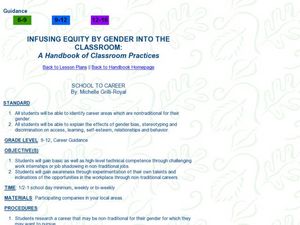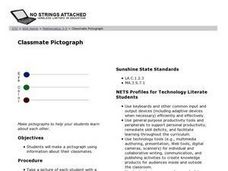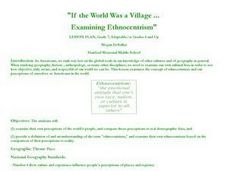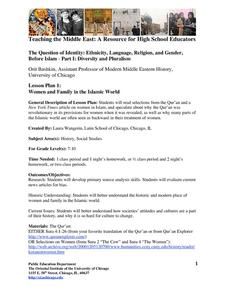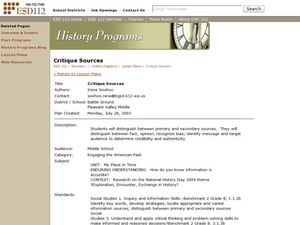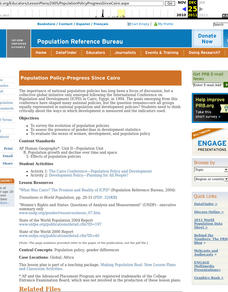Curated OER
Changing Perspectives on the Japanese Internment Experiment
Students discover the characteristics of Japanese internment during World War II. They discuss racist policies and use the internet to gather information to write their own version of history. They write essays from different points of...
Stanford University
Korean War
Learners study the cause of the Korean War. In this World history lesson, Students read excerpts from two different textbooks, one from South Korea, and one from North Korea. They discuss how the cause of the war differs depending on the...
Curated OER
Infusing Equity by Gender into the Classroom: School to Career
Students identify nontraditional career areas for their gender and discuss gender bias and stereotyping. In this nontraditional careers lesson, students research a nontraditional career and shadow the job in the workplace. ...
Curated OER
The Food Pyramid
Fourth graders plan a variety of nutritional meals using the USDA's Food Guide Pyramid as a reference and analyze food labels to plan their meals. They examine and discuss the Food Pyramid, and create dichotomous keys separating food...
Curated OER
Sexism: From Identification to Activism
Learners explore the concept of sexism. In this tolerance lesson, students recognize the attributes of sexism and discuss how they can combat it in their own lives.
Curated OER
Classmate Grid
Students interview classmates and record their findings on a coordinate grid using Inspiration or Kidspiration and digital cameras. This lesson is technology-based and includes resource links.
Curated OER
Ecosystems
Students create plots of land in three different ecosystems and use AppleWorks to collect data for research. This lesson plan includes a downloadable worksheet and can be accomplished in four days.
Curated OER
Classmate Pictograph
Learners create pictographs using their classmates in this technology-based lesson. The lesson uses Inspiration, or Kidspiration, digital cameras, and a downloadable pictograph template.
Curated OER
If the World Was a Village...Examining Ethnocentrism
Seventh graders examine their own perceptions of world's people, compare those perceptions to real demographic data, provide definition and understanding of term "ethnocentrism," and examine their own ethnocentrism based on comparison of...
Curated OER
The Skinny on Sororities
Learners explore the boundary between membership exclusivity and illegal discrimination in private organizations by examining a recent case of alleged discrimination in a college.
University of Chicago
Women and Family in the Islamic World
How does the Qur'an detail the role of women? What modern social issues are linked to Islamic law? Address these questions with your young historians through close analysis of primary and secondary source documents.
Museum of Tolerance
Improving My Community Through Social Action
Action is the heart of change. Encourage class members to not only identify critical social justice issues in their school or community but to take action as well. As individuals or as groups, they research a situation, develop a...
Teaching Tolerance
Community Newsletter
What does it take to develop and publish a newsletter? Young academics create a newsletter with original artwork for their school or community. They explore social justice themes and spread messages of tolerance and inclusion. Scholars...
Free Library of Philadelphia
Resources for Ghost Boys
Jewell Parker Rhodes, the author of Ghost Boys, wanted to bring the historical legacy of Emmett Till and the current topic of racial prejudice into today's young readers' mindsets. Use a reading guide and set of discussion questions to...
Curated OER
Critique Sources
Students distinguish between primary and secondary sources. They study about fact, opinion, and recognize bias. Students find out if information is accurate or not and report on it. For the final project students create an annotated...
Curated OER
Stereo What?
Students define words associated with stereotypes. They identify the difference between stereotype, prejudice and discrimination and give examples of each. They discover their own personal biases.
Curated OER
Using History to Teach Tolerance: A Ripple of Hope
Students investigate the prejudice and racism that has existed in the U.S. for centuries by attending a field trip. In this equality lesson, students visit the Tolerance Museum and discuss the history of the U.S. Students...
Curated OER
A MATTER OF PERSPECTIVE: COLUMBUS IN THE NEW WORLD
Eighth graders study the famous explorer Christopher Columbus. In this World History lesson, 8th graders analyze and compare primary and secondary sources. Students discuss as a class the accomplishments of Columbus....
Curated OER
Dissecting the Media
Students examine an editorial point of view in journalism and explore how this contributes to the West's understanding of events in the Middle East. They discuss the concepts of objectivity and subjectivity, and how tone and vocabulary,...
Curated OER
History Book Review
Students, in American History,read books that take place during certain time periods. They read outside of class with time in class spent on sharing as the book projects are completed.
Curated OER
Population Policy-Progress Since Cairo
Students survey the evolution of population policies. They assess the presence of gender-bias in development statistics. They evaluate the nexus of women, development, and population policy.
Curated OER
Can I Feel Your Pain? A Sculpture Project
Young scholars conduct research dealing with some aspect of human rights in Latin America. They create a sculpture as a response to an instance of repression that touched them from their research. They give a brief oral report on their...
Curated OER
The Search for Character!
Fifth graders define character words, look for real-life examples of the traits "in action," and write an acrostic poem based on one of these qualities.
Curated OER
Respecting Diversity
Students explore the concept of philanthropy. In this service learning lesson plan, students read and respond to The Sneetches by Dr. Seuss. Students discuss self-respect and respect.




